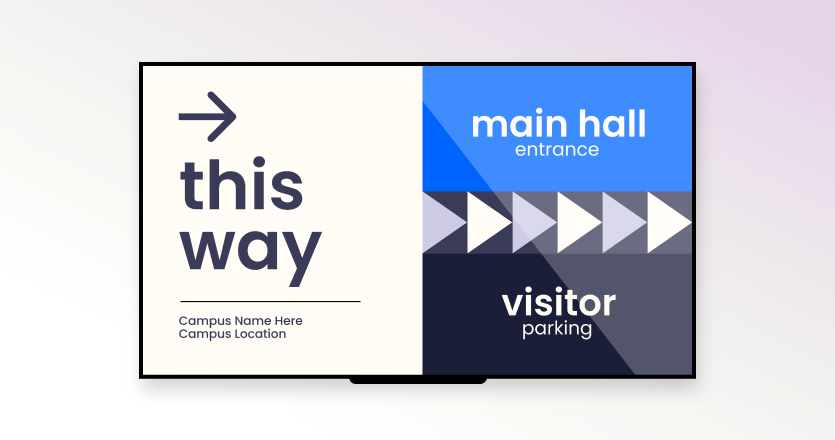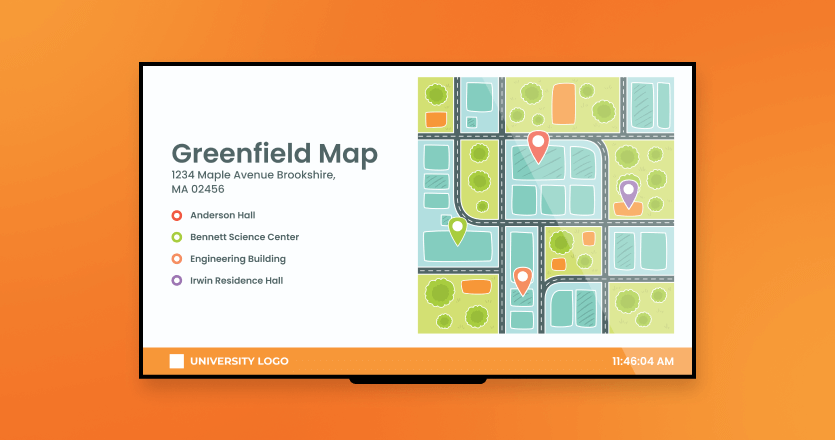If you want to stop witnessing students and visitors with bewildered expressions, struggling to navigate through your educational facility, and searching for ways to enhance the university experience for your students and visitors, look no further than a digital university wayfinding system!
Explore the Ways Digital Displays Enhance Navigation, Information Dissemination, and Campus Safety
What is a university wayfinding system?
University wayfinding, as its name suggests, is the art of easily navigating a university campus or facility with ease. While some may perceive it as simply installing static signs with directional information or arrows, it extends far beyond that. Crafting an effective wayfinding system requires consideration of design, architecture, and even psychological factors to ensure it is both efficient and engaging. The integration of digital signage not only simplifies navigation for staff and students but also potentially yields long-term cost reductions.
What is placemaking?
Placemaking, often referred to as the “sense of place,” captures the connection between individuals and their surroundings. It embodies how a location resonates with people’s emotions and the impressions it leaves on them. Essentially, placemaking is about understanding how a place interacts with individuals’ sentiments, shaping their experiences and perceptions. For instance, a positive experience in a specific location fosters a sense of belonging, security, and affinity towards that place.
Now, you might be thinking how digital signage, particularly wayfinding digital signage, ties into placemaking. Digital signage introduces a new and revitalizing approach to cultivating a sense of community in public spaces. Moreover, it empowers visitors to effortlessly navigate an area while giving them a sense of ownership and fostering trust. This technology facilitates exploration, interaction, and engagement, enriching the overall placemaking experience.
Why an effective navigation system is important for universities?
An effective navigation system serves as the cornerstone of a positive university experience, offering numerous benefits across various aspects of campus life:
Onboarding process
The first days at a university can be overwhelming, with new students juggling myriad concerns, the topmost among them being how to navigate the campus efficiently. Incorporating digital signage screens displaying orientation week schedules, room, and class names, as well as animated directional arrows to key areas, can significantly ease the transition for incoming students. By engaging them early on and providing clear guidance, universities can foster a strong connection with students right from the start.
Last minute changes
Schedule changes are inevitable in a university’s dynamic environment. Digital signage proves invaluable in promptly communicating such updates to students and staff. With the ability to update information in real-time from any location, university administrators can ensure everyone stays informed and adapts to changes seamlessly.
Emergencies
During emergencies, particularly in facilities housing large populations of young adults, ensuring the safety of everyone is paramount. Digital screens offer an effective means of communication in such situations. Young adults are naturally drawn to digital displays, making them an ideal platform for delivering critical instructions and guidance. By leveraging digital signage, universities can communicate emergency procedures swiftly and efficiently, minimizing confusion and enhancing safety protocols.

Benefits you’ll earn from a university wayfinding system
Enhanced accessibility
The most obvious benefit of a university wayfinding system is the effortless navigation it offers to all individuals, including students and visitors. With digital signage screens strategically placed in common areas, displaying comprehensive information about campus locations, universities can ensure that no one gets lost or faces difficulties in finding their way around.
Time and energy savings
Implementing an effective wayfinding system reduces wasted time and energy caused by getting lost or repeatedly asking for directions. By providing clear and intuitive directional signs, students can conserve their energy for more important tasks, leading to increased productivity and reduced frustration.
Cost saving
While initially, investing in a digital signage wayfinding system may seem costly, it offers long-term savings. By eliminating the need for printing materials and paper-based signage, universities can significantly reduce operational expenses. Additionally, transitioning to digital signage supports environmental sustainability efforts, further contributing to cost savings and ecological responsibility.
Positive visitor experience
A well-designed wayfinding system enhances the overall visitor experience. By providing clear and user-friendly navigation, universities can create a positive impression on visitors, ensuring they feel welcome and valued. Positive experiences encourage return visits and word-of-mouth recommendations, bolstering the university’s reputation and attracting prospective students and stakeholders.
Brand identity reinforcement
Consistent use of branding elements in the university wayfinding system reinforces the institution’s brand identity. From signage design to color schemes and typography, every aspect of the wayfinding system can reflect the university’s brand personality and values. This cohesive branding approach enhances brand recognition and fosters a sense of community and pride among students, faculty, and visitors.
The 7 types of college wayfinding signs
When discussing wayfinding signs, the first thing that typically comes to mind is providing directions to aid navigation. However, there’s much more to it than that. We’ve compiled a list of all the types of college wayfinding signs needed to ensure a complete and positive experience:
1. Informational
These signs offer generic information about the campus, its various facilities, and destinations. They are particularly valuable for newcomers, providing descriptions of every location to help freshmen become more familiar with the university.
2. Directional
Directional signs are perhaps the most common and recognizable. Usually depicted as arrows, they guide individuals to various places around campus, facilitating navigation and reducing confusion.
3. Identification
This type of sign displays relevant information such as building names, department titles, or designated areas, helping individuals identify their locations within the larger campus context.
4. Regulatory
Regulatory signs communicate specific rules, regulations, and restrictions. Whether indicating speed limits, no-entry zones, parking regulations, or other campus-specific guidelines, regulatory signs contribute to a secure and organized campus environment. By promoting compliance, these signs help prevent accidents and conflicts.
5. Maps
Map signs provide a comprehensive wayfinding overview not only of the university but also its surroundings, including parking areas, pathways, and critical locations. They often include labeled icons that denote every relevant feature, allowing individuals to chart their routes, locate specific destinations, and make informed navigation decisions.
6. Emergency
Emergency signs are arguably the most crucial, enhancing safety during urgent situations. They guide students and visitors to emergency exits, first aid stations, fire extinguishers, and assembly points, providing this critical information quickly and effectively.
7. Interactive
Interactivity enhances engagement, and when combined with wayfinding, it can significantly improve the experience for all individuals. Consider incorporating interactive kiosks within your university to offer clear and personalized assistance to anyone in need.

How to set up a campus wayfinding system?
Got One Already? Take it to the Next Level!
Discover how to improve your existing university wayfinding system in just 3 easy steps:
- Interviewing students
A straightforward and effective method to enhance your directional signs is by simply interviewing students and visitors to understand their true needs. This way, you will precisely identify areas for improvement and create a more effective campus wayfinding system. - Include diversity
Remember that your digital wayfinding system serves not only your regular campus community but also occasional visitors such as parents or maintenance workers. Ensure inclusivity by considering their needs as well. Additionally, don’t overlook individuals with disabilities, color-blind students, or those who speak different languages. - Simplify instructions
Avoid overthinking and overcrowding your signs. Instructions should be clear and easily readable for everyone. Focus on simplicity, using familiar words, maps, and arrows that are immediately understandable. Utilize colors and fonts that are easy on the eyes and visible from a distance. Additionally, provide maps via apps or downloadable formats for easy access, possibly through the use of QR codes within your digital displays.
Why you need Yodeck
Yodeck provides universities with an efficient and powerful wayfinding system. With a plethora of customizable templates available, you can effortlessly match your brand identity without the need for design skills. Moreover, Yodeck seamlessly integrates with leading apps like Canva, empowering your digital signage displays to their fullest potential.
In conclusion, a well-executed university wayfinding system is essential for enhancing the campus experience for students, faculty, and visitors alike. By leveraging innovative solutions like Yodeck, universities can streamline navigation, improve accessibility, and strengthen their brand identity. With user-friendly customization options and seamless integration with popular apps, creating an effective wayfinding system has never been easier.
